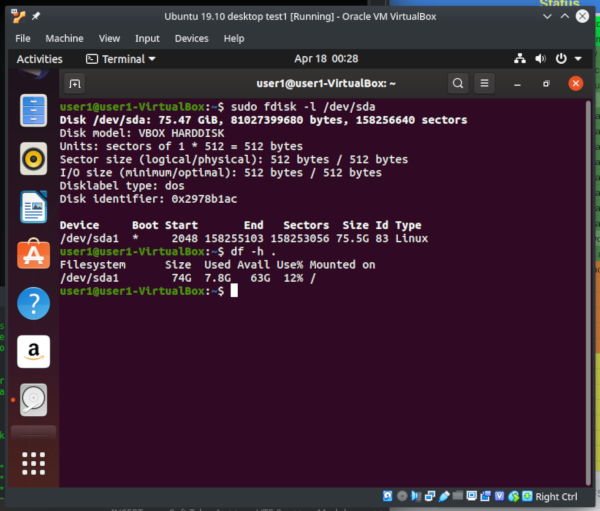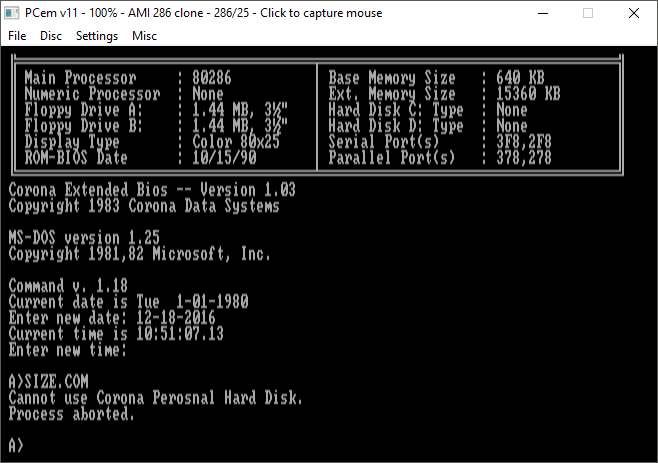

Once you have written the effects to the disk you can use a utility called partprobe to make the kernel re-read the partition table as shown in Figure 1.3. However, if you don’t want to keep the changes you can navigate to the “Quit” button or just press the “q” key. Once you have finished with your partitioning you can simply select the “Write” button to have the effects written to the disk. Once you have create the new logical partition you should have something similar to Figure 1.2.

This progress is similar to creating a primary partition, the only difference is you need to select logical instead of primary. Once the partition has been create and that it is the third partition in our scenario we will now need to create a logical partition.
#DOS DISK SIZE FREE#
The next question you will be asked is “Add partition at beginning of free space” you just have to select “Beginning”. Once you are happy with the layout you can click the “New” button and then select primary by pressing the return key, you will then be asked how big you want the partition in megabytes so in our example we will be using 1024 megabytes. So back to creating a partition, we are going to create two partitions, the first partition we will create will be one gigabyte and will be a primary partition and the second partition will be also one gigabyte but will be a logical partition. Figure 1.1 shows what happens when you create four primary partitions.įigure 1.1: Maximum of four primary partitions.Īs you can see from Figure 1.1 the rest of the disk space becomes unusable when you have four primary partitions. When dealing with partitions you are only allowed to create the maximum of four primary partitions, if you want more partitions you need to create the forth partition as an extended partition which will house logical partitions. The next step is to select the “New” function to begin creating the new partition, you will be asked what type of partition you want i.e. Once the partition has been deleted the “FS Type” column should change to “Free Space” and you should now see a new function called: “New”. Once you have had a look around with the cfdisk utility we can begin to create our first partition, as you can see in Figure 1 the sda3 partition has a file system already installed on it so we will first need to navigate to the delete function and delete the partition. Figure 1 also shows the functions that are available, using the left and right arrow keys you can navigate to each function. The command used to start the cfdisk utility is cfdisk followed by the disk partition you would like to work with, in this article we will be using “/dev/sda”.Īs you can see from Figure 1, a nice, clean and simple interface appears showing the current state of the partition table. The first partition utility that we are going to use is cfdisk, this utility is very similar to the fdisk utility with the only difference being the curses based interface as shown in Figure 1. This is an empty partition that we will be using through out this article. This partition were SUSE Linux Enterprise Server 10 SP1 is installed.

This partition is a Linux swap partition which is about 2155MB. Table 2 lists the current partition table that we will be working with. We will also look at partitioning in a batched mode using the parted utility. In the first section of this article we are going to look at partitioning the hard disk drive using three different tools, we will start with the easiest utility first and work our way up to the more advance utility. When using parted for manipulating partition tables the effects are written on the fly. The parted utility is a much more powerful partitioning utility as it provides a batch and a non-batch mode.
#DOS DISK SIZE WINDOWS#
The fdisk utility that is ported with Linux is similar, if not identical to Microsoft Windows fdisk. The fdisk partition utility is the standard partitioning utility for manipulating partition tables. The cfdisk is a curses based partitioning tool similar to fdisk only with a curses based interface. The partitioning utilities that we will look at are listed in Table 1. We will also look at resizing the ext3 and ReiserFS file systems. In this article we are going to look at disk management, this includes partitioning the hard disk drive using three different partition management utilities.


 0 kommentar(er)
0 kommentar(er)
